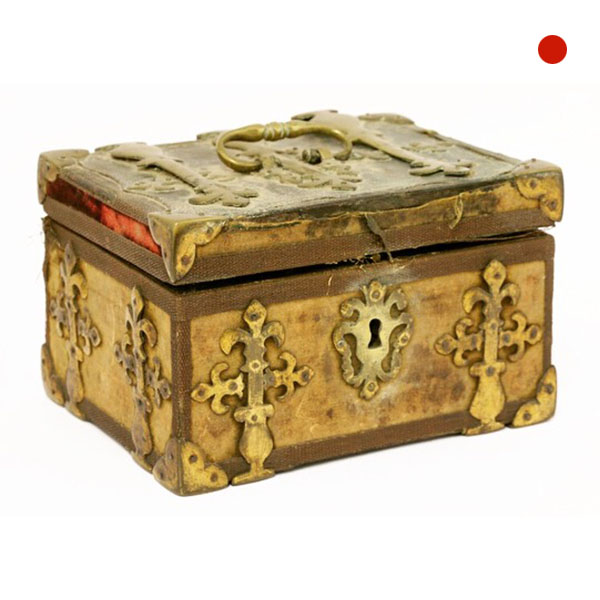
17th-18th Century Silk Covered Strongbox Jewel Casket
SOLD
Request Information
Follow Us
17th-18th Century Silk Covered Strongbox Jewel Casket
Fit for a Queen…
From time to time an object can certainly grab your imagination, this casket of small proportions is no exception. The casket has a lovely hand-written note stating, ‘The jewel box originally belonged to Queen Elizabeth and came direct into the family’. Now, boxes of this form though usually veneered in oysters of Kingwood and
occasionally shagreen, is thought to date between 1675-1700 which would place this box around 100 years too late for the Elizabethan period. It is, however, possible that the casket belonged to Queen Elizabeth and could have been made some 100 years before this style became ‘mainstream’ given the quality of the silver braid, gold plated hand-cut metalwork and the quality of the once bright red silk velvet, not to mention, bright green silk interior.
To our knowledge, this casket is the only example to be recorded of this exceptionally small size and in silk velvet, with hand-cut and filed, not cast, strap-work. Examples of strongbox or coffre fort can be found in oyster cut hardwoods, marquetry and occasionally shagreen, in the most important collections and museums, to name a few – Ham House, Victoria and Albert Museum, Met, Burghley House, Levens Hall, etc. A walnut example on stand was also supplied by royal cabinet maker Gerrit Jensen to Colonel James Grahme of Levens Hall in 1688. However, it should be noted that this is not a coffre fort it is a casket. Coffre forts purpose was to transport items of importance from one’s estate to one’s carriage and to be screwed to the floor using large bolts housed in the side rails. This casket was most likely made to house a single item of importance and was possibly presented as a gift.
The note states – “The jewel box originally belonged to Queen Elizabeth and came direct into the family. The cloak fastener is what gentleman in the olden times used to fasten on the left shoulder a long piece of cloth thrown over They have been many many years in the family. Mrs C Bradbent Granddaughter C Hobbs”
Regardless of whether or not the casket was once the property of Queen Elizabeth, it is a beautiful, untouched and extremely rare item fit for the regalest of collections.
Condition
The piece is in exceptional original condition. Minor conservation to preserve.
Provenance
Literature
Dimensions
PREVIOUSLY SOLD

17th Century North Italian Needlework Tapestry, circa 1680
17th Century North Italian Needlework Tapestry, circa 1680 SoldFollow Us17th Century North Italian Needlework Tapestry, circa 1680 Late 17th-century North Italian needlework panel, circa 1680, of a party of courtiers arriving at an Inn....

George IV Regency Exotic Wood Specimen Parquetry Games Box or Jewellery Box
George IV Regency Exotic Wood Specimen Parquetry Games or Jewellery Box SoldFollow UsGeorge IV Regency Exotic Wood Specimen Parquetry Games or Jewellery Box An extremely rare and fine example, decorated to all surfaces with exotic timbers....

17th Century William and Mary Period Kingwood Oyster Strongbox or Coffre Fort
17th Century William and Mary Period Kingwood Oyster Strongbox or Coffre Fort SoldFollow Us17th Century William and Mary Period Kingwood Oyster Strongbox or Coffre Fort A fine large and rare kingwood oyster strongbox or Coffre Fort, circa...
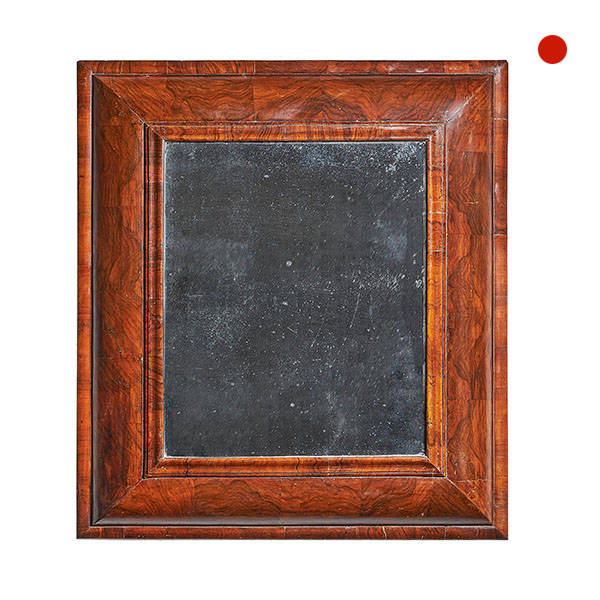
Large 17th Century William and Mary Figured Walnut Cushion Mirror
Large 17th Century William and Mary Figured Walnut Cushion Mirror SOLDFollow UsLarge 17th Century William and Mary Figured Walnut Cushion Mirror The age patinated mercury mirror plate is bordered with a fine cross-grain ogee moulding....

Large George III 18th Century Mahogany Wine Cooler Cellarette or Jardinière
Large George III 18th Century Mahogany Wine Cooler Cellarette or Jardinière SoldFollow UsLarge George III 18th Century Mahogany Wine Cooler Cellarette or Jardinière A fine and large mid-18th century George III oval mahogany cellarette or wine...
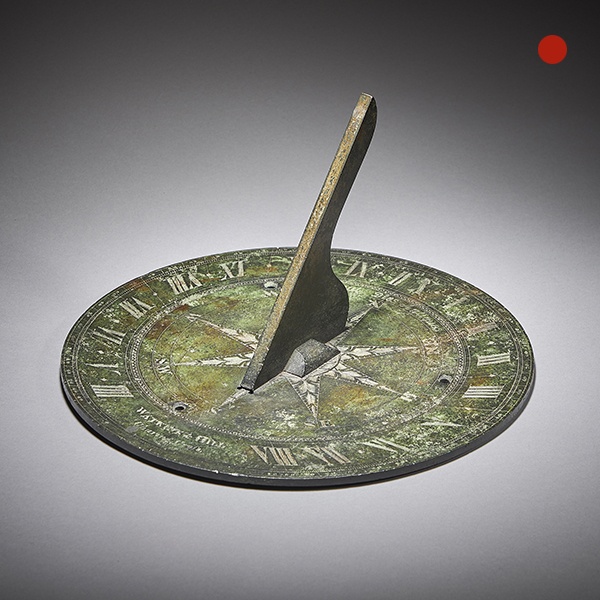
Rare 19th Century Bronze Horizontal Sundial by Watkins & Hill London
Rare 19th Century Bronze Horizontal Sundial by Watkins & Hill London £2,600 Follow UsRare 19th Century Bronze Horizontal Sundial by Watkins & Hill London A beautifully weathered circular bronze sundial by Watkins & Hill, first...

17th Century North Italian Needlework Tapestry, circa 1680
17th Century North Italian Needlework Tapestry, circa 1680 SoldFollow Us17th Century North Italian Needlework Tapestry, circa 1680 Late 17th-century North Italian needlework panel, circa 1680, of a party of courtiers arriving at an Inn....

George IV Regency Exotic Wood Specimen Parquetry Games Box or Jewellery Box
George IV Regency Exotic Wood Specimen Parquetry Games or Jewellery Box SoldFollow UsGeorge IV Regency Exotic Wood Specimen Parquetry Games or Jewellery Box An extremely rare and fine example, decorated to all surfaces with exotic timbers....

17th Century William and Mary Period Kingwood Oyster Strongbox or Coffre Fort
17th Century William and Mary Period Kingwood Oyster Strongbox or Coffre Fort SoldFollow Us17th Century William and Mary Period Kingwood Oyster Strongbox or Coffre Fort A fine large and rare kingwood oyster strongbox or Coffre Fort, circa...

Large 17th Century William and Mary Figured Walnut Cushion Mirror
Large 17th Century William and Mary Figured Walnut Cushion Mirror SOLDFollow UsLarge 17th Century William and Mary Figured Walnut Cushion Mirror The age patinated mercury mirror plate is bordered with a fine cross-grain ogee moulding....

Large George III 18th Century Mahogany Wine Cooler Cellarette or Jardinière
Large George III 18th Century Mahogany Wine Cooler Cellarette or Jardinière SoldFollow UsLarge George III 18th Century Mahogany Wine Cooler Cellarette or Jardinière A fine and large mid-18th century George III oval mahogany cellarette or wine...

Rare 19th Century Bronze Horizontal Sundial by Watkins & Hill London
Rare 19th Century Bronze Horizontal Sundial by Watkins & Hill London £2,600 Follow UsRare 19th Century Bronze Horizontal Sundial by Watkins & Hill London A beautifully weathered circular bronze sundial by Watkins & Hill, first...
YOU MAY ALSO LIKE
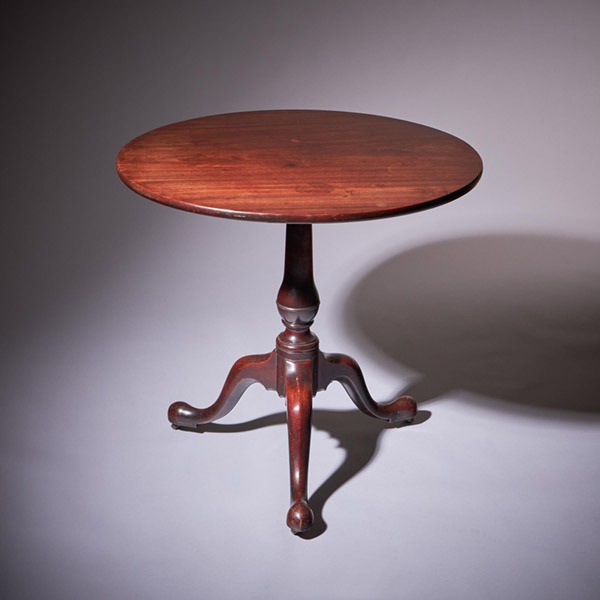
18th Century George III Mahogany Tripod Table, Circa 1770
18th Century George III Mahogany Tripod Table, Circa 1770 £2,200Follow Us18th Century George III...
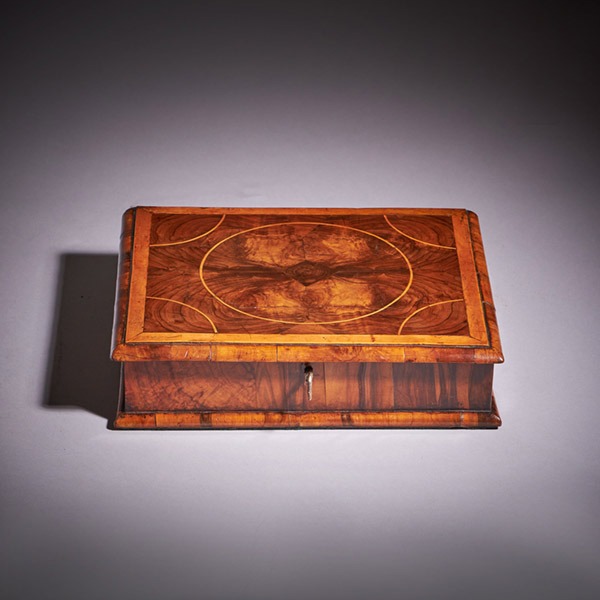
Fine William and Mary 17th Century Olive Oyster Lace Box
Fine William and Mary 17th Century Olive Oyster Lace Box £2,600Follow UsFine William and Mary 17th...
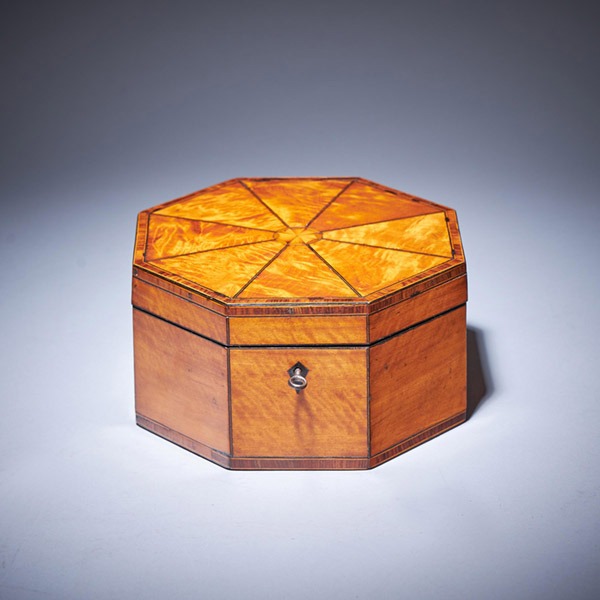
A Fine and Rare George III Octagonal Figured Satinwood Box, C.1790
A Fine and Rare George III Octagonal Figured Satinwood Box, C.1790 £2,200Follow UsA Fine and Rare...

A Rare and Vibrant Framed 18th Century George II Needlework Picture, Circa 1730
A Rare and Vibrant Framed 18th Century George II Needlework Picture, Circa 1730 £16,000Follow UsA Rare and Vibrant Framed 18th Century George II Needlework Picture, Circa 1730 A rare and vibrant early 18th century George II pictorial...
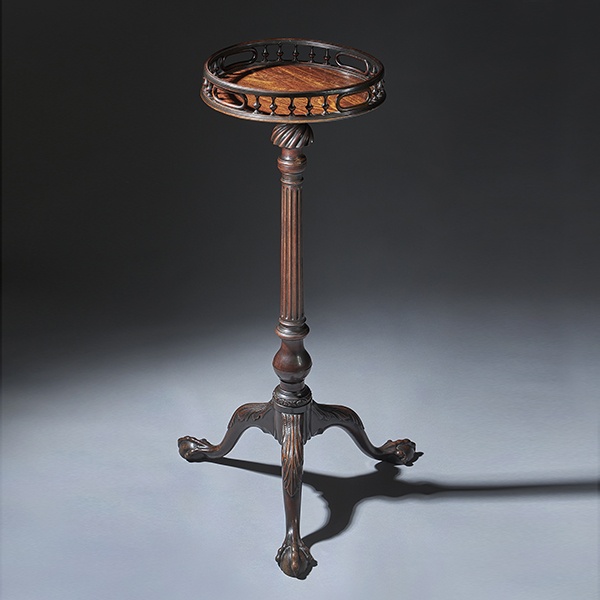
A Fine George II 18Th Century Chippendale Period Carved Mahogany Torchiere. Circa 1755-1765, England
A FINE GEORGE II 18TH CENTURY CHIPPENDALE PERIOD CARVED MAHOGANY TORCHIERE Circa 1755-1765, England £25,000Follow UsA FINE GEORGE II 18TH CENTURY CHIPPENDALE PERIOD CARVED MAHOGANY TORCHIERE, Circa 1755-1765, England An exquisitely fine and...
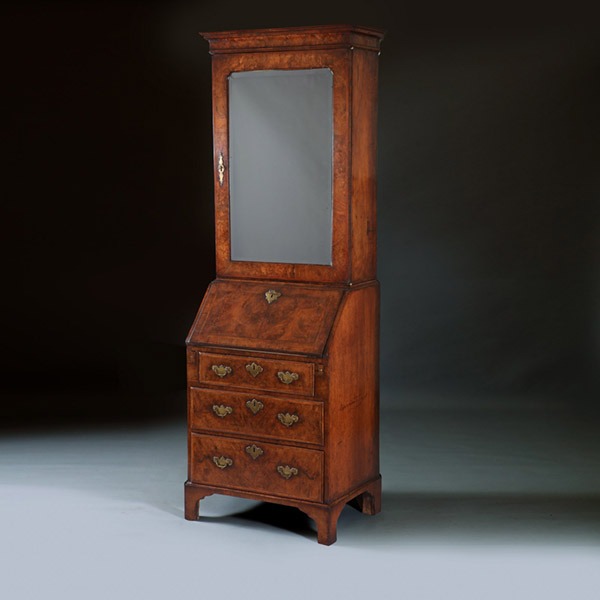
A Fine Early 18th Century George I Burr Walnut Bureau Bookcase, Circa 1715
A Fine Early 18th Century George I Burr Walnut Bureau Bookcase, Circa 1715 £11,500Follow UsA Fine...

18th Century George III Mahogany Tripod Table, Circa 1770
18th Century George III Mahogany Tripod Table, Circa 1770 £2,200Follow Us18th Century George III...

Fine William and Mary 17th Century Olive Oyster Lace Box
Fine William and Mary 17th Century Olive Oyster Lace Box £2,600Follow UsFine William and Mary 17th...

A Fine and Rare George III Octagonal Figured Satinwood Box, C.1790
A Fine and Rare George III Octagonal Figured Satinwood Box, C.1790 £2,200Follow UsA Fine and Rare...

A Rare and Vibrant Framed 18th Century George II Needlework Picture, Circa 1730
A Rare and Vibrant Framed 18th Century George II Needlework Picture, Circa 1730 £16,000Follow UsA Rare and Vibrant Framed 18th Century George II Needlework Picture, Circa 1730 A rare and vibrant early 18th century George II pictorial...

A Fine George II 18Th Century Chippendale Period Carved Mahogany Torchiere. Circa 1755-1765, England
A FINE GEORGE II 18TH CENTURY CHIPPENDALE PERIOD CARVED MAHOGANY TORCHIERE Circa 1755-1765, England £25,000Follow UsA FINE GEORGE II 18TH CENTURY CHIPPENDALE PERIOD CARVED MAHOGANY TORCHIERE, Circa 1755-1765, England An exquisitely fine and...

A Fine Early 18th Century George I Burr Walnut Bureau Bookcase, Circa 1715
A Fine Early 18th Century George I Burr Walnut Bureau Bookcase, Circa 1715 £11,500Follow UsA Fine...


